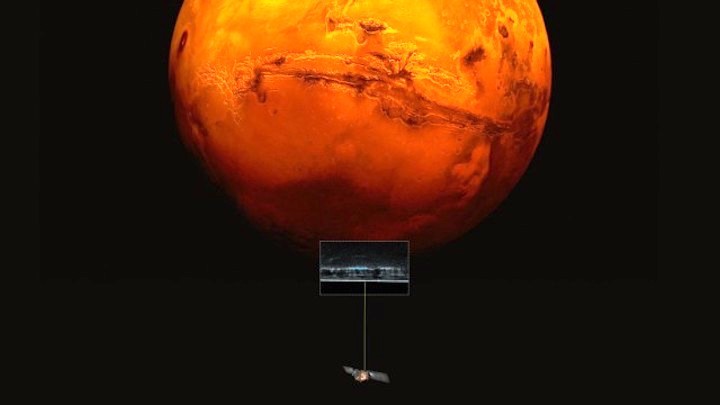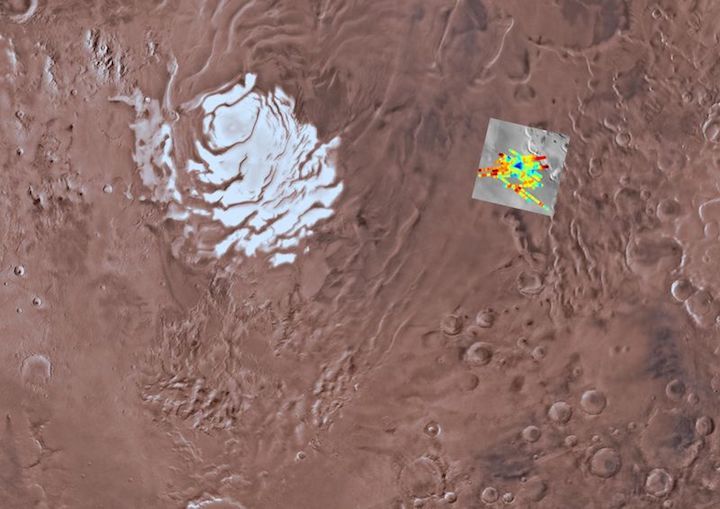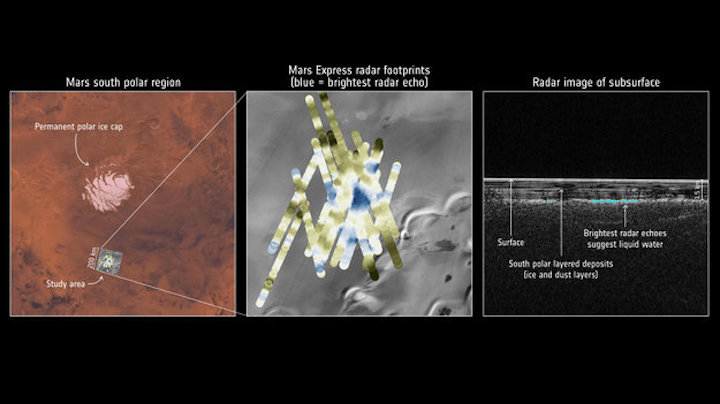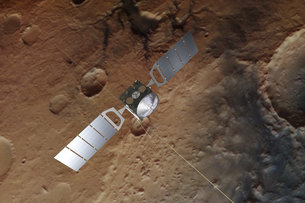Radar data collected by ESA’s Mars Express point to a pond of liquid water buried under layers of ice and dust in the south polar region of Mars.

Detecting buried water with radar
Ground-penetrating radar uses the method of sending radar pulses towards the surface and timing how long it takes for them to be reflected back to the spacecraft, and with what strength. The properties of the material that lies between influences the returned signal, which can be used to map the subsurface topography.
The radar investigation shows that south polar region of Mars is made of many layers of ice and dust down to a depth of about 1.5 km in the 200 km-wide area analysed in this study. A particularly bright radar reflection underneath the layered deposits is identified within a 20 km-wide zone.
Analysing the properties of the reflected radar signals and considering the composition of the layered deposits and expected temperature profile below the surface, the scientists interpret the bright feature as an interface between the ice and a stable body of liquid water, which could be laden with salty, saturated sediments. For MARSIS to be able to detect such a patch of water, it would need to be at least several tens of centimetres thick.
“This subsurface anomaly on Mars has radar properties matching water or water-rich sediments,” says Roberto Orosei, principal investigator of the MARSIS experiment and lead author of the paper published in the journal Science today.
“This is just one small study area; it is an exciting prospect to think there could be more of these underground pockets of water elsewhere, yet to be discovered.”

ExoMars image of layered deposits at the south pole of Mars
“We’d seen hints of interesting subsurface features for years but we couldn’t reproduce the result from orbit to orbit, because the sampling rates and resolution of our data was previously too low,” adds Andrea Cicchetti, MARSIS operations manager and a co-author on the new paper.
“We had to come up with a new operating mode to bypass some onboard processing and trigger a higher sampling rate and thus improve the resolution of the footprint of our dataset: now we see things that simply were not possible before.”
The finding is somewhat reminiscent of Lake Vostok, discovered some 4 km below the ice in Antarctica on Earth. Some forms of microbial life are known to thrive in Earth’s subglacial environments, but could underground pockets of salty, sediment-rich liquid water on Mars also provide a suitable habitat, either now or in the past? Whether life has ever existed on Mars remains an open question, and is one that Mars missions, including the current European-Russian ExoMars orbiter and future rover, will continue to explore.
“The long duration of Mars Express, and the exhausting effort made by the radar team to overcome many analytical challenges, enabled this much-awaited result, demonstrating that the mission and its payload still have a great science potential,” says Dmitri Titov, ESA’s Mars Express project scientist.
“This thrilling discovery is a highlight for planetary science and will contribute to our understanding of the evolution of Mars, the history of water on our neighbour planet and its habitability.”
Mars Express launched 2 June 2003 and celebrates 15 years in orbit on 25 December this year.
Quelle: ESA
+++
Untergrund-See auf dem Mars entdeckt

- Astrophysikern gelingt der erste direkte Nachweis, dass nicht nur vor Urzeiten Wasser in flüssiger Form auf dem Mars existiert hat, sondern noch heute dort zu finden ist.
- Mit einem hoch spezialisierten Radarinstrument auf der Weltraumsonde Mars Express wiesen italienische Astrophysiker einen etwa 20 Kilometer breiten, im Untergrund verborgenen See nach.
- Wissenschaftler wissen deshalb aber noch längst nicht, ob die Bedingungen für die Entstehung von Leben gegeben sind.
Anderthalb Kilometer tief unter der Oberfläche des Mars haben Planetenforscher ein beachtliches Reservoir flüssigen Wassers entdeckt. Es ist der erste direkte Nachweis, dass nicht nur vor Urzeiten Wasser in flüssiger Form auf dem Mars existiert hat, sondern noch heute dort zu finden ist.
Mit einem hoch spezialisierten Radarinstrument auf der Weltraumsonde Mars Express, die seit mehr als 14 Jahren um den Roten Planeten kreist, wiesen italienische Astrophysiker einen etwa 20 Kilometer breiten, im Untergrund verborgenen See nach. Das Wasser befindet sich in einer "Planum Australe" genannten Region am Südpol des Mars unter gefrorenen Eisschichten, die bereits bekannt waren.
Das eingesetzte Messinstrument, der Mars Advanced Radar for Subsurface and Ionosphere Sounding, kurz MARSIS, erstellte von 2012 bis 2015 Radarprofile der Südpolregion des Mars. MARSIS sendet Radarstrahlen aus, die unter die Oberfläche vordringen und auch die Eiskappen an den Polen durchleuchten.
Das Radarprofil ähnelt Messdaten, die man von unterirdischen Seen in der Antarktis und in Grönland kennt
Weil die Radarwellen von den Schichten im Untergrund auf unterschiedliche Weise reflektiert werden, können die Astrophysiker auf die Beschaffenheit schließen. Nachdem das Radargerät der Marssonde im fraglichen Gebiet bei insgesamt 29 Überflügen die gleiche verräterische Signatur des Untergrunds geliefert hat, sind sich Forscher um Roberto Orosei von der Universität Bologna sicher, auf Wasser gestoßen zu sein.
Das Radarprofil ähnelt Messdaten, die man von unterirdischen Seen in der Antarktis und in Grönland kennt. Zwar liege die Temperatur am Südpol des Mars unter dem Gefrierpunkt von Wasser, doch sind vermutlich salzige Mineralien mit Elementen wie Magnesium, Kalzium oder Natrium in dem See gelöst, argumentieren die Astrophysiker. Diese können den Gefrierpunkt von Wasser um einige Grad nach unten drücken. Hinzu kommt der Druck der darüber liegenden Eisschichten, der ebenfalls für eine Absenkung des Gefrierpunkts sorgen kann. All diese Effekte sind auch von der Erde bekannt.
Dass es auf dem Mars keineswegs überall staubtrocken ist, dafür fanden Planetenforscher in den vergangenen Jahren immer mehr indirekte Beweise. Dunkle Streifen an steilen Abhängen wie der sogenannten Coprates-Spalte gelten als Indiz dafür, dass immer wieder mal Wasser in flüssiger Form auf der Marsoberfläche auftaucht und an Furchen und Kraterwänden herabrinnt. Dass vor langer Zeit Wasser in großen Mengen über den Mars floss, gilt ebenfalls als sicher. Auch besteht die äußert dünne Atmosphäre des Planeten zu einem kleinen Teil aus Wassermolekülen.
Wasser in gefrorener Form haben Mars-Forscher bereits in gewaltigen Mengen aufgespürt. Mehr als fünf Millionen Kubikkilometer Eis wurden in der Kruste des Planeten gefunden. Würde sich diese Eismenge verflüssigen, stünde der Mars 35 Meter hoch unter Wasser. Wissenschaftler wissen deshalb aber noch längst nicht, ob die Bedingungen für die Entstehung von Leben gegeben sind. Immerhin: Wasser ist eine mögliche Grundessenz, damit sich organische Moleküle zu etwas Lebendigem zusammenschließen. So war es einst auch auf der Erde.
Quelle: Süddeutsche Zeitung
---
Update: 26.07.2018
.
There’s water on Mars! Signs of buried lake tantalize scientists
The lake would be the first body of liquid water ever detected on the red planet, if observations by a European spacecraft are confirmed.
A large saltwater lake seems to lurk under ice near Mars’s south pole. If confirmed, it would be the first body of liquid water ever detected on the red planet and a significant milestone in the quest to determine whether life exists there.
“It’s a very promising place to look for life on Mars,” says Roberto Orosei, a planetary scientist at the National Institute of Astrophysics in Bologna, Italy. “But we do not know for sure if it is inhabited.” On Earth, similar ‘subglacial’ lakes are home to microbial life.
A team of Italian researchers, led by Orosei, reported the discovery on 25 July in Science1. They spotted evidence of the buried lake in radar data from the European Space Agency’s Mars Express spacecraft.
Others say that the work is tantalizing but, like anything else in the controversial hunt for water on Mars, it needs more supporting evidence. “It’s not quite a slam dunk yet,” says Jeffrey Plaut, a planetary scientist at NASA’s Jet Propulsion Laboratory in Pasadena, California, who has searched for water using data from Mars Express2.
If further studies confirm the existence of a lake, it could open new avenues for investigating Mars. Researchers have drilled into subglacial lakes on Earth and sampled the water for signs of microbes, while others are developing technologies to reach a buried ocean on Jupiter’s moon Europa. There are no ice-drilling missions currently slated for Mars — but the latest discovery could change how scientists think about exploring the planet.
“It begins a new line of inquiry that’s very exciting,” says Jim Green, NASA’s chief scientist.
Tantalizing trail
Water appears across Mars today in various forms, left over from a time billions of years ago when the planet was warmer and wetter. Orbiting probes have spotted ice, including buried glaciers, in many locations. Spacecraft have photographed steep slopes whose appearance changes seasonally, as if liquid water is running downhill and leaving dark marks. And NASA’s Curiosity rover has measured water vapour in the planet’s atmosphere.
Orosei and his colleagues found the lake using a radar instrument called MARSIS aboard Mars Express, which launched in 2003. It sends radio waves bouncing off the surface and subsurface layers; the way in which the radar signal reflects back reveals the type of material that is present, such as rock, ice or water. The scientists focused their search on the layers of ice and dust that cover the planet’s south pole.
But the observations were frustratingly inconsistent. Mars Express sometimes saw a bright reflection in several locations, which did not reappear the next time the spacecraft flew over those sites. Finally, in 2012, the scientists decided to have MARSIS send back raw data, instead of performing automated processing before beaming the data to Earth. “This changed everything, and it was much more obvious to spot the bright reflectors,” says Orosei.
The data showed bright reflections coming from a 20-kilometre-long zone in a region known as Planum Australe. After ruling out other possible explanations, such as carbon dioxide ice, the scientists concluded that the reflections were coming from subsurface water.

Radar tracks on Mars's Planum Australe show the location of a potential buried lake (in blue). Credit: USGS Astrogeology Science Center, Arizona State University, INAF
-
Briny depths
The lake is about 1.5 kilometres beneath Mars’s surface and is at least 1 metre deep. To keep from freezing, the water must be very salty, Orosei says — perhaps similar to super-salty subglacial lakes reported in the Canadian Arctic earlier this year3. Salt-rich rocks beneath the Canadian lakes infuse the water and allow it to remain liquid, says Anja Rutishauser, a glaciologist at the University of Alberta in Edmonton. On Mars, salts known as perchlorates might be what’s making the brine; in 2008, NASA’s Phoenix spacecraft found perchlorates in soils near the planet’s northern polar ice.
Mars might have had many similar lakes in the past, when heat rising from deep within the planet melted some of the ice covering its polar regions, says Stephen Clifford, a planetary scientist who proposed the idea in 19874 and now works for the Planetary Science Institute in Houston, Texas. If life once thrived in ancient subsurface lakes, he says, the latest finding “raises support for the idea that life could still persist on Mars”.
With liquid water and the right chemical elements available to supply energy, a buried martian lake would have the ingredients needed to sustain life — as long as it's not too salty, says John Priscu, a biogeochemist at Montana State University in Bozeman. But exploring it won't be easy. Priscu leads a team that aims to drill into Antarctica's subglacial Lake Mercer later this year; hauling tonnes of equipment and fuel to that remote location required weeks of tractors traversing the Antarctic ice sheet. "There's no way you're going to get all that to Mars," he says.
But there are ways to learn more with spacecraft already in play. Green notes that NASA’s InSight probe, which is scheduled to land near the martian equator in November, will measure heat flow in the top 5 metres of the surface there. Scientists can use that data to extrapolate how much heat might be rising from beneath the south polar cap, melting the ice and creating more potential lakes.
Orosei says his team has glimpsed other bright reflections, but isn’t ready to say whether or not they are lakes. More studies using MARSIS, as well as the radar on board NASA’s Mars Reconnaissance Orbiter — which has looked in Planum Australe and not seen the reflections — could help to reveal whether these are actually liquid water or something else, Plaut says.
Quelle: nature






